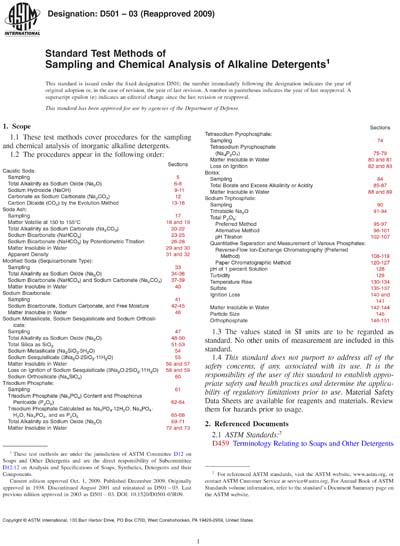Historical
ASTM D501-03(2009)
Standard Test Methods of Sampling and Chemical Analysis of Alkaline Detergents
1.1 These test methods cover procedures for the sampling and chemical analysis of inorganic alkaline detergents.
1.2 The values stated in SI units are to be regarded as standard. No other units of measurement are included in this standard.
1.3This standard does not purport to address all of the safety concerns, if any, associated with its use. It is the responsibility of the user of this standard to establish appropriate safety and health practices and determine the applicability of regulatory limitations prior to use. Material Safety Data Sheets are available for reagents and materials. Review them for hazards prior to usage.
75.1 This procedure describes an indirect determination of tetrasodium pyrophosphate by titration of sulfuric acid liberated by the action of zinc sulfate on an acid pyrophosphate in accordance with the following reactions
This titration is a measure of the pyrophosphate content. This test method for pyrophosphate is inaccurate in the presence of polyphosphates.
108.1 This test method can be used to analyze completely any mixture of low molecular weight phosphates including ortho, pyro, triphosphate, tetrameta and trimeta. The higher molecular weight phosphates can only be determined by difference if the procedure is followed as given here. This test method is specifically designed for completely analyzing commercial sodium triphosphate which seldom contains these higher molecular weight phosphates.
120.1 In addition to the triphosphate content of a sample, this procedure also gives the percentages of orthophosphates, pyrophosphates, and trimetaphosphates, and the combined total of all material with molecular weight higher than pentaphosphate. Tetraphosphates and pentaphosphates are distributed partially in the triphosphate and high-molecular-weight bands but are not ordinarily encountered in commercial triphosphate samples.
120.2 If the procedure is used for analyzing commercial samples of triphosphate that generally contain 1 percent or less of orthophosphate, high-molecular-weight phosphate, and trimetaphosphate combined, the work involved can be considerably reduced without serious loss in accuracy by omitting the two-directional analysis for trimetaphosphate, and disregarding the ortho- and higher molecular weight phosphate zones in the one-directional run. The one-directional chromatographic pattern gives a qualitative picture of the over-all make-up of the sample. If unusually large quantities of one of the minor constituents mentioned above are indicated in the one-directional pattern, this suggested shortened procedure should not be followed.
130.1 There are two types of sodium triphosphate, both of which may be found in commercial samples. Form I hydrates more rapidly than Form II. The relative quantities of each may be determined by the temperature rise test. The procedure described in the following Sections 131-135 has been calibrated against X-ray diffraction analysis. For reliable results it is essential to follow exactly the standard procedure.
ASTM International [astm]

